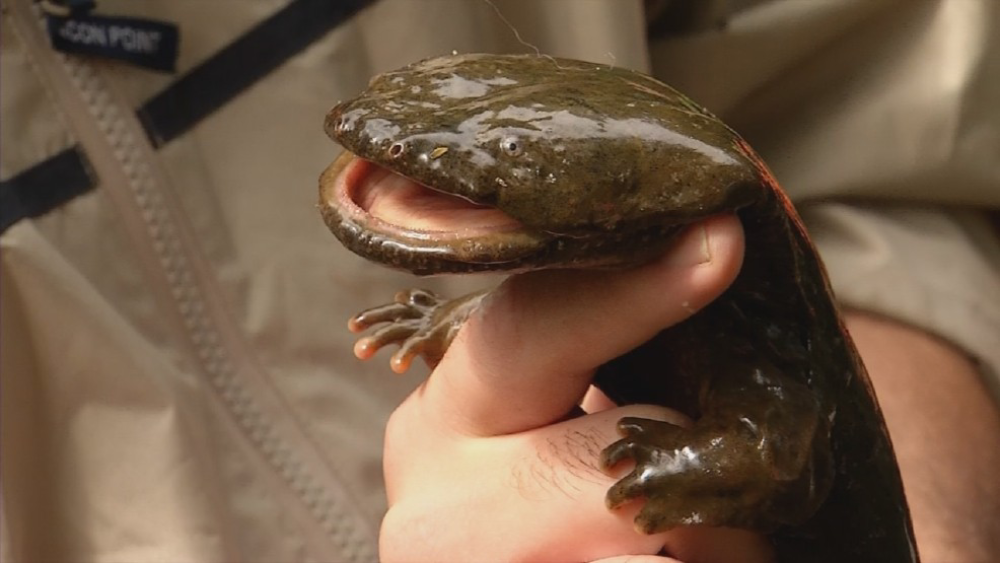In the dark, cool waters of North America’s rivers and streams resides a creature that seems almost mythical in its appearance and habits. The Hellbender, also known as the “snot otter” or “devil dog,” is one of the largest species of salamanders in the world, yet it remains relatively unknown to many. This enigmatic giant holds a crucial place in the ecosystem, yet faces numerous threats to its survival. Join us as we dive into the depths of the Hellbender’s world, exploring its biology, habitat, conservation status, and the efforts being made to protect this fascinating creature.
Anatomy and Biology
The Hellbender (Cryptobranchus alleganiensis) is a species of giant salamander belonging to the Cryptobranchidae family. It has flattened body, wrinkled skin, and distinctive folds along its sides, giving it a somewhat otherworldly appearance. Typically, Hellbenders range from 12 to 29 inches in length, with some individuals reported to reach lengths of over two feet.
One of the most remarkable features of the Hellbender is its ability to respire through its skin, a process known as cutaneous respiration. This adaptation allows it to absorb oxygen directly from the water, making it well-suited to its aquatic habitat. Additionally, Hellbenders possess a sensory system known as “vomeronasal,” which helps them detect chemicals and pheromones in the water, aiding in navigation and communication.
Habitat and Distribution
Hellbenders are primarily found in clear, fast-flowing streams and rivers throughout the eastern United States, with their range extending from New York to Georgia and westward to Missouri and Arkansas. These freshwater habitats provide the ideal conditions for the Hellbender, which requires clean, well-oxygenated water to thrive.
Within these aquatic environments, Hellbenders prefer sheltered areas with ample hiding spots, such as crevices between rocks or submerged logs. These nocturnal creatures are most active at night, venturing out from their hiding places to hunt for prey, which primarily consists of crayfish, small fish, insects, and other invertebrates.

Conservation Status and Threats
Despite their importance in maintaining healthy aquatic ecosystems, Hellbenders face a multitude of threats that have led to population declines in recent years. Habitat loss and degradation, primarily due to factors such as deforestation, urbanization, and agricultural runoff, pose significant challenges to Hellbender survival. Pollution, including sedimentation, chemical contaminants, and nutrient runoff, further exacerbates these issues by degrading water quality and reducing the availability of suitable habitat.
Additionally, the introduction of non-native species, such as predatory fish and crayfish, has disrupted native ecosystems and contributed to declines in Hellbender populations. Climate change also presents a growing threat, as rising temperatures and altered precipitation patterns affect water temperatures and flow regimes, potentially impacting Hellbender habitat.
Conservation Efforts
Recognizing the urgent need to protect Hellbenders and their habitats, conservation organizations, government agencies, researchers, and local communities have launched various initiatives aimed at conserving this iconic species. These efforts include habitat restoration projects, water quality monitoring programs, captive breeding and reintroduction programs, public education and outreach campaigns, and regulatory measures aimed at reducing pollution and habitat destruction.
One notable example is the Hellbender Genome Project, a collaborative research endeavor that seeks to sequence the entire genome of the Hellbender salamander. By studying the Hellbender’s genetic makeup, researchers hope to gain insights into its evolutionary history, population dynamics, and adaptability to environmental change, which could inform future conservation strategies.
Conclusion
The Hellbender, with its bizarre appearance and remarkable adaptations, serves as a symbol of the unique biodiversity found in North America’s freshwater ecosystems. However, this iconic species is facing unprecedented challenges that threaten its very existence. To ensure the continued survival of the Hellbender and the health of the ecosystems it inhabits, concerted efforts are needed to address the root causes of its decline, including habitat loss, pollution, climate change, and invasive species.
So, by raising awareness, supporting conservation initiatives, and implementing sustainable management practices, we can work together to safeguard the future of this fascinating creature and preserve the rich diversity of life in our rivers and streams for generations to come.









